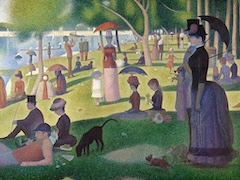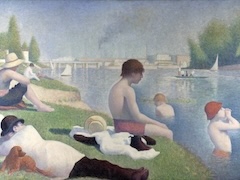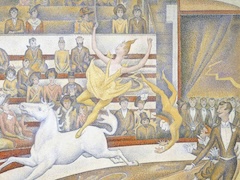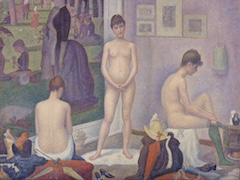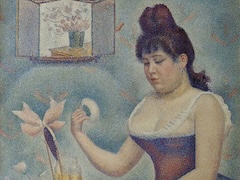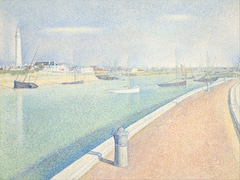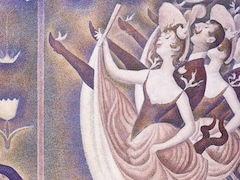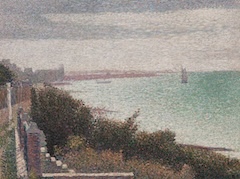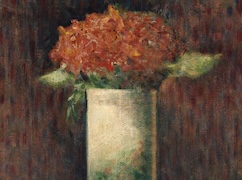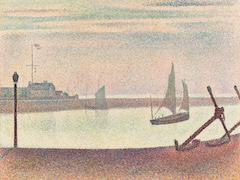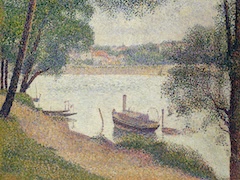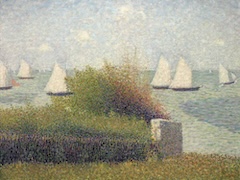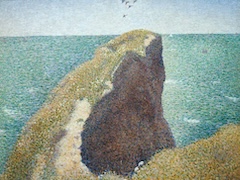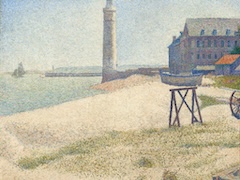Georges Seurat's life and his paintings

Mention Georges Seurat's name, and the first thing that comes to mind is his "pointillism," his painted tapestries of divided color. When his large picture A Sunday Afternoon on the Island of La Grande Jatte appeared in May 1886, he acquired instant fame; the painting's dotted brushwork and its parade of stately figures were immediately taken as a challenge to Impressionism ( the term "Neo-impressionism" was invented the following September by the critic Felix Feneon). Yet Seurat was not alone, for three other artists displaying works in the May exhibition used a similar technique: Camille Pissarro, his son Lucien, and Paul Signac. By 1887 they were joined by Charles Angrand, Henri-Edmond Cross, Albert Dubois-Pillet, Leo Gausson, Louis Hayet, and Maximilien Luce.
The younger artists in this group, those born shortly before or shortly after 1860, had known one another since 1884 when they had helped found the Societe des Artistes indépendantes, a democratic exhibition society that became the center of Neo-Impressionist activities. The allure of their new technique lay chiefly in its claim to being scientific; only the systematic application of natural laws, they said, could capture the illusion of colored light. Applying paint in regular small strokes, they gave their pictures the look of rational order that openly challenged the instinctive and spontaneous art of the Impressionists. The new movement spread abroad in 1887 when Seurat and Pissarro were invited to show with Les Vingt, an avant-garde society in Brussels; by 1889, Neo-impressionism had become the dominant new art in Belgium. In Paris, other artists who were seeking alternatives to Impressionism, among them Vincent van Gogh, Paul Gauguin, Emile Bernard, and Henri de Toulouse-Lautrec flirted for a time with the new style.
Georges Seurat's paintings allow us to reexamine Seurat's theories and their central role in the short-lived Neo-impressionist movement. Although artists and critics alike regarded Seurat as the inventor and leading artist of Neo-impressionism, the ebullient Signac was the more effective propagandist for the movement, and Dubois-Pillet was the group's best organizer within the indépendantes. No doubt Georges Seurat also learned a great deal from Signac, the elder Pissarro, and other comrades. Particularly in need of reappraisal, however, is Seurat's posthumous role as the chief early exponent of "scientific" color and color theory.
The fame of A Sunday on La Grande Jatte, Georges Seurat's best-known painting, goes well beyond histories of art. It has been used as an illustration not only in learned discussions of science and technology but also in advertisements for leisure wear and other fashions. It is no contradiction that Seurat's art has lent itself to these seeming opposites. His work is a compound of different elements; these separate realms reveal, it would seem, several different artists. How do we reconcile the artist who was devoted to color science with the one who loved caricatures and poster art? The artist who drew somber twilight scenes in black crayon with the one who constructed sunlit scenes in sparkling colors? The artist who represented unpeopled seaports with the one who pictured boisterous cafe-café? Like most of us, Seurat was several persons wrapped in one; his apparent contradictions are a complicated weave of many strands, resulting in one artistic fabric.
A century after Seurat's death, we are now able to correct some of the myths that grew up around him. Because he died at the age of thirty-one, he was long believed to have produced only a few pictures and to have died of consumption or some other frailty (so tenacious is the romantic paradigm of an early death). To the contrary, he was tall for his era (five feet, nine and one-half inches), and his friends always described him as robust-"a solid being, a grenadier," according to Signac. He died in an epidemic of virulent diphtheria. As for his productivity, from his one decade of maturity, there survive 6 huge canvases and 60 smaller ones, about 170 wood panels, 230 completed drawings, and 45 studies or fragmentary drawings.
Foremost among the myths surrounding Georges Seurat is the belief (promoted by his earliest commentators) that he was virtually a scientist. Using recipes derived from learned treatises, it was said, he reconstructed colored light dot by dot and calculated his compositions with the aid of geometric formulas such as the golden section. So pervasive is this view that some writers who point out that his dotted technique does not reconstitute colored light then attack him for his failure to be (successfully) scientific. Anists as well as critics have made him the godparent of the significant modern current embracing science and technology.
The concept of Ggeorges Seurat as a cold scientific artist does not readily agree with the caricatural aspect of some of his paintings or with the complexion of most of his drawings, whose swirling lines and strange gray evoke shadowy uncertainty. Preferring these drawings, some observers claim that the true Seurat is to be found in them, not in his renowned dotted paintings; the drawings, worthy of Rembrandt or Francisco Goya, are considered closer to greatness because they fit a definition of art based on instinct and emotion. The split of Georges Seurat into two different artists is based on the separation of rationality and art that remains characteristic of our culture, despite the work of Piero della Francesca, and Juan Gris. Georges Seurat was indeed rational, and he developed a logical method of applying paint (as did Ingres); he theorized acutely and read widely in aesthetics ( as did Eugene Delacroix); he reacted to what he saw nature while transforming it into pictorial structure ( as did Monet). His paintings are not the result of a methodically applied recipe but are the products of creative and experimental talent (as are Matisse's).
To find the whole artist, both poet and technician, we must redefine Seurat's "science." Younger scholars are helping his revision by pointing out that earlier writers greatly exaggerated his dependence upon theory and mathematical formulas. Careful examination of Seurat's paintings proves that his technique evolved slowly our of the craft of the artist and that his supposed dependence upon scientific theory was far less than previously proclaimed. His texts were a crutch that propped up the evolution of his technique; at the end of his life nearly all his "science" was still based upon his boyhood reading of Charles Blanc. Although the regular brushwork of his mature technique seems co support the idea of a scientific artist, the famous dots are not a screen in front of his images. In fact, they are not even dots-they are instead small couches of paint in various shapes that shift and flow with the images and are interlocked with the underlying paint. Moreover, they do not determine a picture's coloration because, although they contribute to it, they are only the final strokes atop a complex net of Brushwork.
Many of Seurat's works draw attention to his brushwork and colors. As we explore his technique, we try to free ourselves from prior assumptions and deduce his evolving techniques from his actual practice; we do not deny his concern for theory, but we do not want it to predetermine what we find in the pictures. The readings that influenced Georges Seurat were mostly from handbooks on aesthetics, not scientific works, and a number of them were written by artists concerned with the craft of painting.
It would be foolish to deny the importance of Seurat's readings in color science. He wanted to be perceived as a technician of art, and so he borrowed from science some of the signs of its authority, including regularity and clarity of pattern. Nothing in color theory would require the systematic apportionment of small strokes as in Seurat's mature work, which constituted not a scientific act but an expression of his role as an inventor. (Even Seurat's painted borders and frames, one of the most idiosyncratic features of his art, were put forward by the artist as responses to natural laws.) Certainly, his-Svengali-like power over his fellow painters owed much to the face char his posture of certitude was especially influential in an age that regarded science and technology as essential instruments of progress. In 1887, briefly converted to Neo-impressionism by Seurat's example, Camille Pissarro called himself one of the "scientific Impressionists" and attacked the "romantic" Claude Monet for the disorder of his brushwork, "which, despite the artist's talent, is no longer in accord with our epoch."
The words "rational" or "disciplined" express what is most often meant when the term "scientific" is employed by or about Seurat. The artist himself revealed this juncture of personal temperament and ambition more than once: at the end of his notes on Delacroix taken in 1881, for example, Seurat wrote, "It's the strictest application of scientific principles seen through a personality." His readings in Blanc, David Sutter, and others are laced with the morality of discipline, and the need for rules and order; this proclivity confirms what we know of his background and temperament. The impulse to organize is a moral and social urge; it is the basis of Seurat's ambition to reform Impressionism. He referred to his major paintings as "canvases of combat".
If we are to use the word “scientific” to describe Georges Seurat's approach, we must consider how his “science” is entwined with other aspects of his art. For example, his theory of expressive lines holds that upward lines induce a feeling of gaiety, downward lines sadness, and horizontal lines calmness. Seurat had thought about the emotional significance of linear direction when, during his school days, he had read about Humbert de Superville's theory in Blanc's Grammaire. This concept was reinforced by his acquaintance after 1886 with Henry, who gave the sanction of contemporary science. The linear substructure of the late paintings may therefore seem traceable to Humbert's and Henry's ideas. It is equally dependent on Seurat's flat, decorative line, which in turn cannot be separated from his penchant for caricature. For Humbert, Henry, and Seurat, these lines provided the underlying support for a composition - they did not regard this emphasis on the linear as a movement toward abstraction. Like his caricatural line, other features of Seurat's art can be interpreted from different vantage points. The classicism of Bathers at Asnières and La Grande Jatte, for instance, is deeply enmeshed with his “primitivism”. The monumental figures and the well-regulated order demonstrate that Seurat was hir to the Beaux-Arts tradition whose roots were in classical art. These elements, however, are not copied from antique or Renaissance art but have analogies with Egyptian relief sculpture and painting, early Renaissance art, and popular broadsides.
After 1886 most of Georges Seurat's friends remarked on his combination of radical and conservative features. They welcomed him as a leading member of progressive art circles, but his reserved demeanor reminded them of his origins in a bourgeois family and of his traditional schooling at the École des Beaux-Arts. Gustave Kahn's succinct account of his character is consistent with that given by other friends:
Underneath a reserved demeanor, always dressed in dark blue or black, with an upright and neat appearance that led Edgar Degas to nickname him, in a moment of humor, ‘the notary', he had a temperament marked by kindness and enthusiasm. Silent in large groups, in smaller ones, and among friends he spoke readily about his art in terms of goals, in terms of technical deliberations.”
Not everyone welcomed Seurat's conservatism. When irritated by Seurat, Pissarro once wrote: “Seurat comes from the École des Beaux-Arts, he's impregnated with it”. That Georges Seurat could be conservative in some regards and innovative in others is not surprising - these traits were often joined in the ambitious bourgeoisie from which he sprung. His father rose from clerk and bailiff to wealthy real-estate speculator; he and his wife provided their high station by providing the funds for their son's devotion to the arts - Georges to painting, his brother to the theater. Georges Seurat's ambition to modernize art with the aid of science fits well with his family's position. He absorbed the values of the progressive middle class, whose old patterns and regulations by necessity gave way to invention and technology.
Georges Seurat's determination to forge a new art appeared early; at sixteen he began to search for an “optical formula”, devoting himself to color in opposition to his teachers' insistence upon drawing. Labeled Communard by fellow students for his fierce independence and perhaps also for radical political views, he quit the École des Beaux Arts at age twenty. He did not follow his schoolmates' paths toward official success, nor did he undertake their religious and classical subjects. First apprenticing himself to the naturalist tradition in drawing and painting, he began to assimilate Impressionism by about 1883. That too was only an apprenticeship, for in 1886, with La Grande Jatte, he declared Impressionism passe and himself its reformer by virtue of his scientific color and restoration of the classical values of synthesis and essential form.
Most of Seurat's admirers in the press were not just literary innovators but political radicals as well, although few adhered to a party. They included Paul Adam, a maverick leftist who supported the reactionary nationalist general, Georges Boulanger; Jean Ajalbert, a radical lawyer and naturalist poet Paul Alexis, a naturalist friend of Zola's, Georges Lecomte, an admirer of the anarchist journalist and editor, and Emile Verhaeren, a Belgian socialist poet. Most of these men were disillusioned with electoral politics and were strongly drawn to the anarchist-communist movement, although it was not until the early 1890s that anarchism pervaded this avant-garde. By then Seurat's fellow Neo-impressionists Camille and Lucien Pissarro, Maximilien Luce, and Paul Signac were self-declared anarchists, as was the critic Felix Feneon; Charles Angrand and Henri-Edmond Cross, also Neo-impression, were sympathetic to the cause if not active in it.
Given these friendships, many have believed that Georges Seurat himself was an anarchist. He may have been. The conclusions of such speculation about Seurat's political beliefs, however, depend on superimposing in the 1880s those ideas from anarchism's years of effervescence, that followed his death. By that time Signac and Feneon wanted to assimilate Seurat into their beliefs; their eagerness was logical for two reasons. One was that anarchism, as Signac proclaimed, did not require pictures of poverty or other iniquities of capitalism but instead sponsored individual freedom in the arts. A painting of progressive style, wrote Signac, regardless of its subject, could deliver "a solid blow of the pick to the old social edifice." As an innovator, Georges Seurat could therefore be said to have contributed to anarchism's forward thrust. The second reason for Seurat's posthumous adoption by the anarchists was that his drawings and paintings had consistently favored the democratic and the popular, from his early drawings and paintings of peasants, workers, and suburban factories to his late pictures of urban entertainment. These last works, Signac said, embraced a critical view of their era of transition from decadent capitalism to the future workers' society.
Nonetheless, there are some contrary indications to the portrayal of Georges Seurat as an anarchist. Luce was associated with the anarchist communists by 1888 and Pissarro and Signac no later than 1890, yet they never mentioned Seurat's participation in their activities or, as far as we know, did they attempt to seek it. Their letters imply that they considered him aloof from such engagement. He had opportunities to engage in political activities, but the years from 1888 to 1891 were instead the period of his greatest withdrawal and secretiveness, inspired partly, it seems, from jealousy of his prerogatives as the founder of Neo-impressionism. On balance, it appears most likely that Seurat was on the left but probably not an anarchist; the evidence, largely circumstantial, strongly supports the view that the young artist was a left-wing republican. Other vanguard painters, like Manet a generation earlier, also balanced conservative social lives with the oppositional stances that indicated their defiance of established authorities (it is easier, however, to prove a position on the left for Manet than for Seurat).
What cannot be doubted is that Seurat's art grew out of an enlightened middle-class culture whose progressive tendencies he embodied. By basing his technique on the scientific method, he proclaimed his faith in the ability of humankind to construct order out of sensory data, to subject even the ephemeral and changing aspects of color-light to close observation and then to artistic pattern. By painting mural-scale canvases he carried out, in a more contemporary form, many republican beliefs that art should have a public and moral purpose; by picturing types rather than unique beings. Seurat also endorsed the republican view that the social should take precedence over the individual.
Georges Seurat's faith in rational procedures was not unquestioning. He was not an innocent who thought that scientific rules would initiate the millennium. The psychological isolation of his figures, the poignant emptiness of his seaport, and the almost frantic sense of order in his late works - all were marked by foreboding. On the one hand, Seurat isolated himself from society through his temperamental reserve, which indicates a lack of confidence in social cohesion; on the other hand, he reached out to society through an art that asserted order and control.
We will retain this sense of order as Seurat's leading characteristic, despite his doubts and despite our fears, in this troubled era, that artistic control is a metaphor for social control. We grant Georges Seurat that place in history modernism has forged for him because he was determined to impose rational order over experience is, after all, of of the central currents of French painting, from Poussin and David to Delaunay and Leger. Sophisticated and naive, classical and primitive, conservative and radical, Georges Seurat looked to the past and the future.

